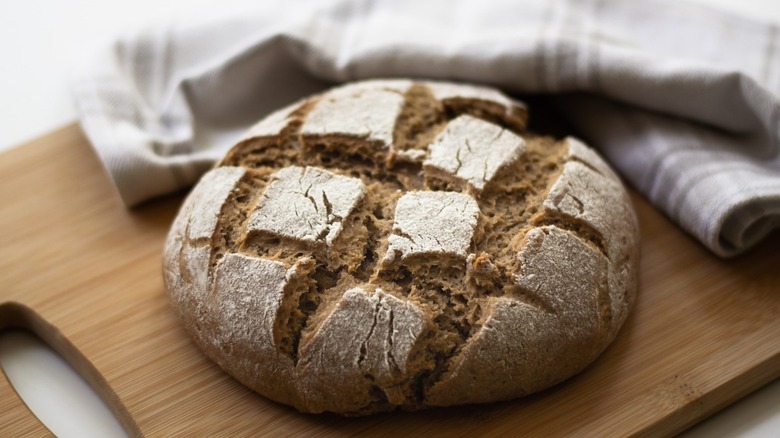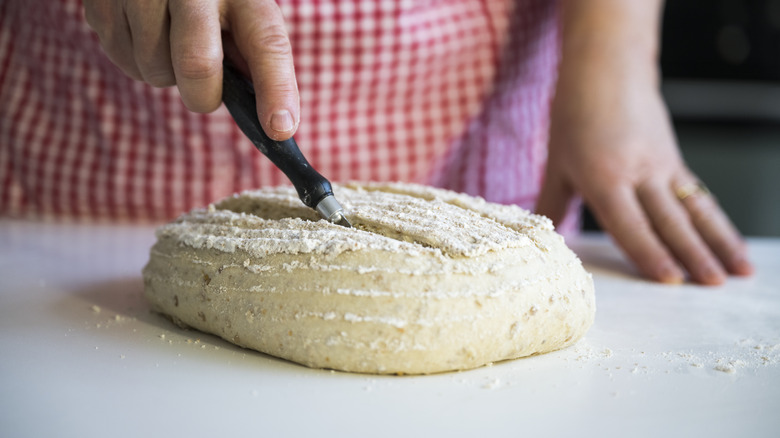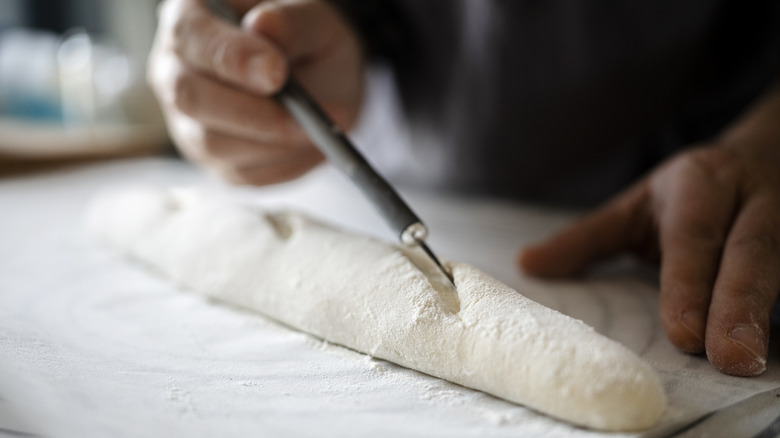The Easiest Scoring Pattern For Your First Loaf Of Bread
Athletes score runs, goals, and touchdowns, but bakers score something else: bread. The prize for scoring? A beautiful, evenly cooked, tasty loaf of bread to share with friends.
Scoring is when a baker uses a blade to cut slashes in their raw dough after it has been proofed and shaped, just before it goes in the oven. If you've ever baked bread before, you know that the dough expands rapidly when first put in the oven. Scoring helps control this expansion, creating a better technical bake and more beautiful finished loaf. As bread bakes, the steam from inside the dough needs a place to escape. Without that escape route, the steam will forge its own path, creating cracks in your dough.
If you're new to scoring dough, start out with the simplest pattern of them all — the hashtag. If you have some experience, you can score based on the shape and type of bread. Sourdough bread often features criss-cross or square scores, while bâtards use a series of diagonal cuts. Typically, round loaves need even, shallow cuts around the dough, while longer baguette-style loaves should have deeper cuts running across the width of the loaf, almost resembling the rungs on a ladder.
Best scoring pattern for beginners
With four quick, easy strokes you can create a simple, yet decorative pattern in your bread. To score with the hashtag shape, take your cutting device and slash two parallel lines in the top of the loaf. Then, rotate the bread a quarter turn and add two more lines perpendicular to the first two. Use medium pressure (about the same amount of pressure you use when writing) and keep your blade at an angle roughly 45 degrees from the dough. Your slashes should be about a quarter of an inch deep and the finished product should look like a hashtag.
As your scoring skills improve, you can move on to more complex — and fun — scoring patterns. Try playing a game of tic-tac-toe in your new hashtag. Score a fancy tree with deep cuts for the trunk and branches, plus shallower cuts for leaves. You can even get meta and score a wheat stalk into your new loaf of whole wheat bread.
Remember not all breads are baked the same, and likewise don't all require the same scoring process. Loaves baked in a pan, as well as plaited breads and flatbreads, already have the proper shaping needed and therefore don't require any scoring. When in doubt, check your recipe to see if they have any scoring notes for you.
Tips for better scoring
Professional bakers use a number of different tools to create the perfect score, including a lame (pronounced "lahm"), double-edged razor blade, or kitchen scissors. No matter the tool you choose, be sure your blade is sharp. A blunt blade may catch in the loaf, smearing the dough instead of slicing cleanly through it. This can result in a jagged, puckered look on your final loaf.
If you're handling a particularly sticky dough, try wetting your blade with water or spraying it with cooking oil between slashes. To create a nice contrast between the dark, crunchy crust and the white softness of the inner bread, sprinkle the loaf with flour just before you score the dough.
Be mindful of your scoring. If you go too deep, you might hit an air pocket, leaving your finished loaf rather deflated. Always hold the blade steady and make calculated slashes so as not to hurt yourself or ruin your bread's aesthetics. Try not to go too slowly, however, as hesitating may cause tears in the bread. This takes practice, but you'll get better in time.



